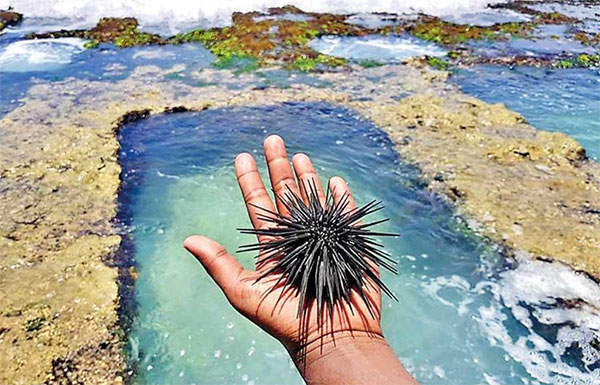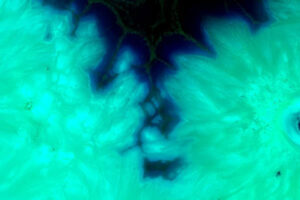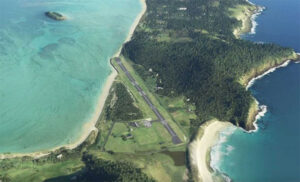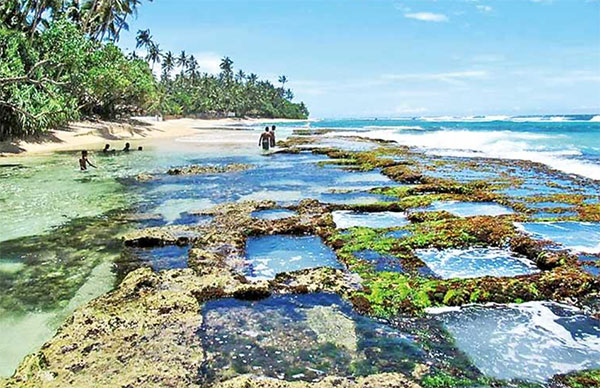
This beach, located about 10 Km from Galle city, is one of the most beautiful beaches on the south coast. In recent times, this beach has managed to attract more domestic tourists, and this may be due to its remarkable uniqueness. The uniqueness of this place is that there are several naturally formed stone pools.
The people who live here say that about 60 years ago, coconut husks were soaked in these pools to obtain coconut oil.
If you come from Colombo by train, you can reach this beach by getting off from Talpe railway station and walking 500m towards Matara. Otherwise, you can take a highway bus to Galle city and board a bus heading towards Matara and get off near Talpe beach and reach the beach.
Due to the rapid growth and development of the tourism industry, the number of hotels that have come up in the southern coastal region is huge. After enjoying the pristine beauty of Galle Fort, many foreigners visiting Galle go to Unawatuna or nearby beaches for more experiences. Talpe Beach is another such tourist haven. A few naturally formed pools in a limited area of Talpe beach have become a tourist haven these days.
The foaming waves crashing on the beach crash into the rocks and scatter the water into the square pools there. Especially in the morning, these water filled pools can be seen with green color. Many people come here to take bath in the small pools. At first glance, the location is natural, but we had a friendly meeting with a nearby villager to find the secret and retrospect of being square.
These pits, which were abandoned about ten years ago, were used for piling logs. Because this is the only place in Sri Lanka where white coconut coir was planted and the people who did that work in this area dug this rock in the sea into square squares. Today these pits can be seen as beautiful Tadagas and people go down in these pits to have fun and bathe. An average man can stay in this pit until almost his body and thus many pits of different sizes can be seen in this event.
Especially in the morning, these pits can be seen and sometimes due to the tides, these can be covered and the sea water body can come to the shore. Then it can be dangerous to descend into these. No matter how much beauty and fun this Tadaga brings, the people who come here know that there is a certain danger nearby. That is, the sea creature called Ikiri can be seen abundantly in this event.
The creature clings to this rock like a small tennis ball with pegs attached to it, but does no harm to man. But man should be very careful of these animals because they can trample them. If the creature steps on your bare feet, those many spines can cause a painful, bleeding wound on your sole. Therefore, you should be more careful with these black-colored stingers.
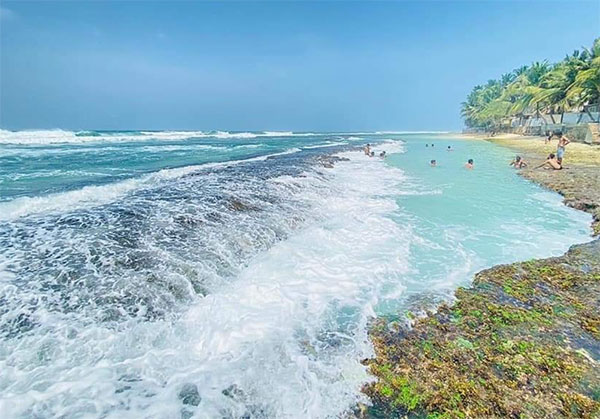
On the day we visited, there were stingrays all over the reef and we carefully picked one up. They can be on the walls even inside the Tadaga, so it is essential to be careful and watchful when going down into the Tadaga. And Talpe beach is where local and foreign tourists have drowned in the sea for several years. Therefore, we should always be careful while bathing in sea water. Because unlike waterfalls in the mountains, we are well aware of the dangers of sea waves kissing the shore.
After bathing in Talpe, we next left to go to Mirissa via Koggala. After walking 25 kilometers towards Matara, kissing the salty sea breeze between the beautiful beaches, we reached the city of Mirissa. We came to the Mirissa Sri Sudarshanarama Temple and from there we walked along the footpath leading to the beach.
After a small thicket, the footpath leads to a coconut grove. It is a place where the land protrudes into the sea like a small point. The plot, which is a few meters above sea level, is called Coconut Tree Hill. This place is also a very popular tourist stop recently. Due to the palm trees spread out in a certain beautiful pattern, the beauty of this small point can be intensified. Due to this reason, this place is also full of local and foreign tourists. Descending into the sea below this point is quite dangerous. Spread over a small plot of land, the place was immaculately clean. We also saw that the environment and the people who hang around there behave in a decent manner because it is forbidden to do strange or immoral activities in this place.
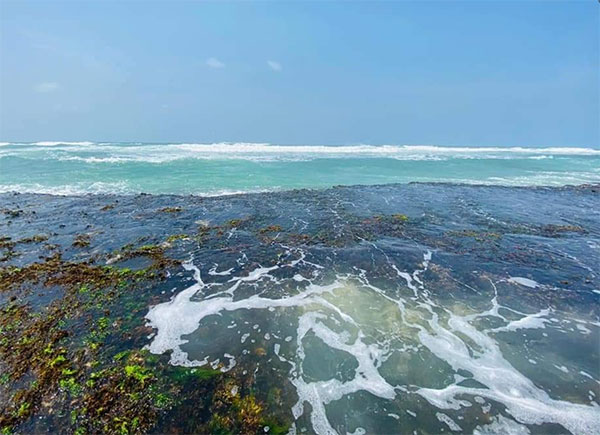
This hillock, which is a jewel of the Mirissa coast, is located close to Weligama Bay. The Mirissa coastline runs to Weligama through the Weligama Bay and we could see the Polwatta river joining the Weligama coastline. Likewise, Mirissa fishing harbor was located next to it.
Mirissa is a popular place from the past and a large area was hit by the 2004 Tsunami. Currently, Mirissa coast and surrounding areas have become a tourist destination. Because in these events, not only hotels are used to accommodate foreign tourists, but according to the government’s new concept, even small or large houses are financed to be developed to accommodate foreigners, so housing-related stands were seen in many areas.
Mirissa is famous for another special event. That is to go to see whales (Whale Watching) These whales can be seen when going towards the sea from the coast of Mirissa. For that you have to pay some money and get a boat service. There are several coastal incidents related to coral reefs around Mirissa and the number of drowning deaths is significant.
Because no matter how beautiful the Mirissa beach is, if you accidentally go into the sea, you can get caught in the currents or tidal waves and be pulled into the sea. Mirissa beach is ideal for water bathing, where Mount Pol Ruppa can be seen in the distance. It can be clearly seen that the position of the coconut trees in that hillock is really wonderful.

As there was more time left in the day, we started walking along the coast towards Matara. No matter how much the sun hindered us, we saw white gentlemen and white ladies basking in the scorching sun. Spring flowers could still be seen blooming in the sun-burnt watkeiya bushes and irregular people could be seen hanging around the beach blocking the way and harassing foreigners due to informal trade activities. Sometimes we wondered if walking along the beach was more difficult than we were walking in the mountains as we trudged along on the sand and basked in the sun. Because most of our experiences were in the mountains full of green fog and cold, and the beach and coastal experiences were few.
Anyway, by evening we reached Matara along the main road and boarded the train to Colombo. Another special thing must be said here. When visiting the southern region, from Galle Fort through Talpe and Mirissa to Matara, you can see beautiful beaches, bathing piers as well as beautiful hotels and tourist service centers. That is why it is best to plan your trip well. Talpe Beach is a beautiful place full of dangers. Ikirins are common in these areas and we should be careful not to step on them while walking on the beach and going down into the Talpe Tadaga. Because we met local and foreign tourists who were injured by sticks and sticks on the bottom of their feet. The beach of Mirissa is graced by Mount Pol Ruppa and it is very important not to pollute the environment and avoid disturbing foreigners. Because these places are always monitored by the police and even the villagers are always aware of the activities going on in these areas.
Similarly, the rod method, which is a traditional method of catching fish, can be seen in these events. One should be careful even when climbing on those sticks that are thrown in the sea because the fishermen still use them to do their fishing. Anyway, the trip we went to find the beauty of the south coast away from the mountains was important to remember. The salty sea breeze and the densely populated environment remind us of the wild environment of the mountain valleys.
